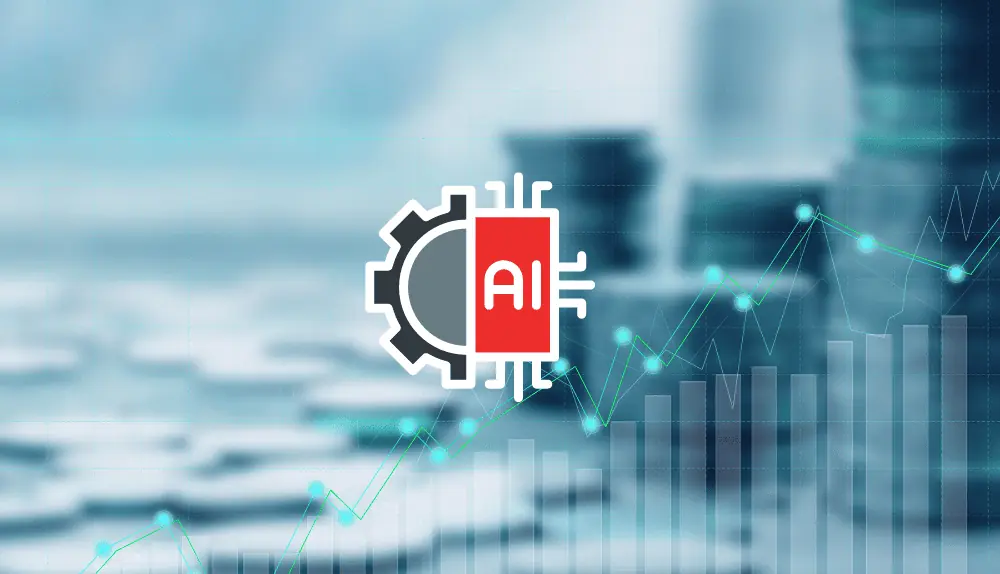In the ever-evolving landscape of finance, Artificial Intelligence (AI) continues to redefine traditional lending practices. Embedded lending, a groundbreaking approach that seamlessly integrates financial services into non-financial platforms, holds immense potential for revolutionizing the borrowing experience. At the forefront of this transformative shift lies generative AI, a powerful technology that leverages advanced algorithms to generate tailored solutions.
By harnessing the capabilities of generative AI, embedded finance is paving the way for more personalized lending experiences for borrowers while empowering lenders with precise risk assessments. This convergence of AI and embedded finance has the potential to reshape the future of lending, unlocking new possibilities and opportunities for financial inclusion.
What is Generative AI?

Generative AI, also known as generative adversarial networks (GANs), is an innovative branch of artificial intelligence that focuses on creating new content rather than simply analyzing or classifying existing data. Unlike traditional AI models that rely on extensive training datasets, generative AI has the remarkable ability to generate new data, such as images, text, and even music, that resembles the patterns and characteristics of the training data it has learned from.
At the heart of generative AI are two neural networks: the generator and the discriminator. The generator network creates new data samples by learning from the patterns and features of the training data, while the discriminator network evaluates the generated samples, distinguishing them from real data.
Through an iterative process, the generator network continuously improves its ability to produce more realistic and high-quality content while the discriminator network becomes more adept at detecting generated data. This adversarial interplay between the two networks drives the generative AI model to produce increasingly convincing outputs.
Generative AI has demonstrated its proficiency in a wide range of applications, including image synthesis, text generation, video creation, and even drug discovery. It holds immense potential for creative industries, research fields, and problem-solving scenarios where the ability to generate new and innovative content is highly valuable.
What is Embedded Finance?

Embedded finance denotes the integration of financial services and products into non-financial platforms and applications, such as e-commerce websites, mobile apps, or even social media platforms. It enables consumers to access and use financial services seamlessly within the context of their everyday activities without having to navigate to separate financial institutions or platforms.
Traditionally, financial services were provided by banks, insurance companies, or other specialized institutions. However, with embedded finance, businesses from various industries can offer financial services directly to their customers. For example, an e-commerce platform can provide instant loans or installment payment options at the point of purchase; a ride-sharing app can offer driver insurance coverage; or a social media platform can facilitate peer-to-peer payments between users.
Embedded finance aims to enhance convenience, accessibility, and customer experience by eliminating the need for users to switch between different applications or platforms to access financial services. It leverages APIs (Application Programming Interfaces) and partnerships between financial service providers and non-financial companies to integrate financial capabilities into existing digital ecosystems seamlessly.
By embedding financial services, businesses can unlock new revenue streams, enhance customer loyalty, and provide a more holistic user experience. Furthermore, embedded finance has the potential to expand financial inclusion by reaching underserved populations who may not have easy access to traditional banking services.
Overall, embedded finance represents a paradigm shift in the way financial services are delivered, enabling consumers to engage with and benefit from financial services in a more integrated and convenient manner.
How Generative AI is Revolutionizing the Embedded Finance?
Generative AI is poised to revolutionize the landscape of embedded finance, bringing forth a wave of transformative advancements that benefit businesses and consumers alike. By harnessing the power of generative AI algorithms, embedded finance platforms can deliver personalized, efficient, and accessible financial services, paving the way for innovation and growth within the financial industry.
Enhanced Customer Experiences
Generative AI is reshaping embedded finance by offering enhanced customer experiences that cater to individual needs and preferences. By analyzing vast amounts of data, generative AI algorithms gain insights into user behavior, enabling embedded finance platforms to deliver personalized financial services. For instance, retail websites can utilize generative AI to analyze a customer’s purchase history, financial data, and browsing patterns to offer tailored loan or credit options at the point of sale. This level of personalization not only enhances customer satisfaction but also fosters long-term loyalty and engagement.
Improved Risk Assessment
Generative AI is transforming risk assessment in embedded finance, enabling more accurate and efficient evaluations of borrower profiles. Through the analysis of extensive datasets, generative AI algorithms can identify patterns and indicators of creditworthiness, empowering lenders to make informed decisions. This results in reduced risk exposure and improved loan portfolio management. Additionally, generative AI can dynamically adapt risk assessment models based on real-time data, ensuring ongoing accuracy and responsiveness to changing market conditions.
Fraud Detection and Prevention
Embedded finance platforms face the constant challenge of detecting and preventing fraudulent activities. Generative AI algorithms have proven to be instrumental in this regard, offering advanced fraud detection capabilities. By continuously analyzing patterns and anomalies within financial transactions, generative AI can swiftly identify suspicious activities and flag them for further investigation. This proactive approach to fraud prevention helps safeguard both businesses and consumers, enhancing trust in embedded finance platforms.
Automated Customer Support
Generative AI is revolutionizing customer support within embedded finance by providing automated and intelligent assistance. Natural Language Processing (NLP) algorithms powered by generative AI can understand and respond to customer inquiries and requests in real time. This enables embedded finance platforms to offer round-the-clock support, streamline query resolution, and enhance customer satisfaction. Virtual assistants powered by generative AI can handle routine inquiries, offer product recommendations, and even guide users through complex financial processes, simplifying the overall customer experience.
Democratization of Financial Services
Generative AI is driving the democratization of financial services, making them more accessible to underserved populations. Embedded finance platforms that leverage generative AI can extend financial inclusion by reaching individuals who lack traditional banking services. By offering simplified onboarding processes, personalized financial products, and alternative credit assessment models, generative AI-powered embedded finance platforms open up avenues for individuals who may have been previously excluded from traditional financial systems.
Innovation and Product Development
Generative AI fuels innovation within embedded finance, enabling the development of new and creative financial products and services. By leveraging generative AI algorithms, businesses can uncover valuable insights, identify emerging trends, and explore untapped opportunities. This data-driven approach enhances product development, enabling embedded finance platforms to introduce innovative offerings that meet evolving customer needs. From customized investment portfolios to automated budgeting tools, generative AI facilitates the creation of cutting-edge financial solutions.
Generative AI is driving a paradigm shift in embedded finance, revolutionizing customer experiences, risk assessment, fraud prevention, customer support, financial accessibility, and product development. The integration of generative AI into embedded finance platforms not only enhances personalization and efficiency but also promotes financial inclusion and fosters innovation within the financial industry. As generative AI continues to advance, it will undoubtedly shape the future of embedded finance, creating transformative opportunities and redefining the way financial services are delivered and experienced.
Benefits of Generative AI for Embedded Finance

Generative AI is revolutionizing the landscape of embedded finance, offering unique advantages that drive innovation, efficiency, and customer-centricity. By harnessing the capabilities of generative AI algorithms, embedded finance platforms can leverage its distinct benefits to deliver personalized services, optimize decision-making, and create novel financial solutions. Here, we will explore the unique advantages of generative AI for embedded finance.
Hyper-Personalization
Generative AI enables embedded finance platforms to achieve hyper-personalization by analyzing vast amounts of data and understanding individual user preferences and behaviors. This personalized approach empowers platforms to offer tailored financial products and services that precisely align with the unique needs of each customer. By leveraging generative AI algorithms, embedded finance platforms can dynamically adjust loan terms, customize investment portfolios, and provide personalized budgeting recommendations. Hyper-personalization enhances customer satisfaction, loyalty, and engagement, setting embedded finance platforms apart from traditional banking experiences.
Real-Time Decision-Making
Generative AI facilitates real-time decision-making within embedded finance platforms. Generative AI algorithms can provide instant risk assessments, automate underwriting processes, and make rapid loan approval decisions by continuously analyzing data and processing information at high speeds. Real-time decision-making enables embedded finance platforms to seize market opportunities, respond swiftly to customer needs, and streamline operational efficiency. This agility in decision-making enhances the overall user experience and ensures optimal utilization of resources.
Creative and Innovative Solutions
Generative AI unlocks creativity and fosters innovation within embedded finance. By generating new and diverse financial possibilities, generative AI algorithms inspire the development of innovative solutions. For example, generative AI can assist in the creation of novel investment strategies, personalized savings plans, or dynamic insurance coverage based on individual risk profiles. This unique advantage allows embedded finance platforms to differentiate themselves, attract new customers, and cater to emerging market demands. The ability to constantly experiment and generate inventive financial solutions positions embedded finance platforms at the forefront of innovation.
Scalability and Efficiency
Generative AI enables embedded finance platforms to scale and operate efficiently. Generative AI algorithms optimize resource allocation and streamline operations by automating processes and reducing manual intervention. For instance, loan origination processes can be automated using generative AI, reducing processing time and minimizing administrative costs.
Furthermore, generative AI-powered chatbots and virtual assistants provide round-the-clock customer support, improving response times and enhancing efficiency. Scalability and efficiency are critical advantages that allow embedded finance platforms to handle increasing transaction volumes, reach wider audiences, and deliver seamless experiences.
Advanced Risk Assessment
Generative AI revolutionizes risk assessment within embedded finance platforms. By analyzing vast datasets and identifying patterns, generative AI algorithms provide advanced risk assessment capabilities. These algorithms can detect subtle indicators of creditworthiness and evaluate risks more accurately.
Embedded finance platforms can leverage this advantage to optimize loan pricing, customize repayment terms, and manage credit portfolios effectively. The precision and sophistication of generative AI-powered risk assessment enhance profitability, minimize defaults, and reduce overall risk exposure.
Enhanced Security and Fraud Detection
Generative AI strengthens security measures and fraud detection in embedded finance platforms. By analyzing vast amounts of transactional data, generative AI algorithms can identify anomalies, patterns, and suspicious activities in real time.
This proactive approach helps identify and prevent fraudulent transactions, safeguard customer data, and ensure compliance with regulatory requirements. The robust security measures provided by generative AI instill confidence in users, building trust in embedded finance platforms and protecting their reputation.
Generative AI offers unique advantages for embedded finance, including hyper-personalization, real-time decision-making, creativity and innovation, scalability and efficiency, advanced risk assessment, and enhanced security. By leveraging these benefits, embedded finance platforms can deliver exceptional customer experiences, optimize processes, drive innovation, and remain competitive in a rapidly evolving financial landscape.
Generative AI is poised to redefine the future of embedded finance, unlocking unparalleled opportunities for growth, customer engagement, and financial inclusion.
Future of Generative AI and Embedded Finance
The future of generative AI and embedded finance holds immense potential for transformative advancements in the financial industry. As technology continues to evolve and new innovations emerge, integrating generative AI into embedded finance platforms will lead to groundbreaking developments and shape the way financial services are delivered and experienced. Here are some key aspects that highlight the future of generative AI and embedded finance:
Enhanced Personalization
Generative AI will continue to play a pivotal role in delivering highly personalized financial experiences. Advanced algorithms will analyze vast amounts of data to gain deeper insights into customer preferences, behaviors, and financial needs. This will enable embedded finance platforms to offer customized solutions and recommendations in real time, catering to individual circumstances and fostering long-term customer loyalty.
Augmented Risk Assessment
The future of embedded finance will witness further advancements in risk assessment through generative AI. Algorithms will become more sophisticated in analyzing complex datasets, allowing for even more accurate and dynamic risk evaluations. This will result in improved credit decision-making, reduced default rates, and enhanced portfolio management, enabling lenders to make data-driven decisions and optimize profitability.
Blockchain and Smart Contracts
The integration of generative AI with blockchain technology and smart contracts holds great potential for embedded finance. Smart contracts provide self-executing agreements that automatically trigger financial transactions based on predefined conditions. Generative AI algorithms can help analyze and optimize the terms and conditions within smart contracts, ensuring transparency, security, and efficiency in embedded finance processes.
Predictive Analytics and Forecasting
Generative AI algorithms will continue to evolve and become more proficient in predictive analytics and forecasting. By leveraging historical data and market trends, embedded finance platforms can anticipate customer needs, identify potential risks, and make informed predictions about market movements. This will enable better investment decisions, more accurate pricing models, and enhanced financial planning for both businesses and individuals.
Voice and Natural Language Processing
Voice-enabled interfaces and natural language processing powered by generative AI will revolutionize customer interactions in embedded finance. Users will be able to conduct financial transactions, make inquiries, and receive personalized recommendations using voice commands and natural language, providing a seamless and intuitive user experience. This advancement will further enhance accessibility and convenience in accessing embedded finance services.
Regulatory Compliance and Security
Generative AI will continue to play a crucial role in ensuring regulatory compliance and strengthening security measures in embedded finance. As financial regulations evolve, algorithms will be developed to analyze and interpret regulatory requirements, enabling embedded finance platforms to stay compliant. Additionally, generative AI-powered fraud detection systems will become more sophisticated in detecting and preventing fraudulent activities, safeguarding the integrity of transactions and user data.
Continued Financial Inclusion
The future of embedded finance powered by generative AI will prioritize financial inclusion. With advancements in alternative credit assessment models and the use of non-traditional data sources, embedded finance platforms will be able to extend their services to underserved populations, such as those with limited access to banking services or thin credit histories. This will bridge the gap and empower individuals and businesses with financial opportunities previously unavailable to them.
Overall, the future of generative AI and embedded finance holds immense promise for revolutionizing the financial industry. With enhanced personalization, augmented risk assessment, the integration of blockchain and smart contracts, predictive analytics, voice interfaces, regulatory compliance, and continued financial inclusion, generative AI will shape a future where financial services are more accessible, efficient, and tailored to individual needs. As technology advances, we can expect exciting developments that will redefine the way we interact with and benefit from embedded finance.
Final Words
In conclusion, the integration of generative AI into embedded finance platforms is poised to revolutionize the financial industry and reshape the way we access and experience financial services. The discussed benefits and future prospects of generative AI in embedded finance highlight its potential to enhance personalization, optimize risk assessment, drive innovation, improve efficiency, ensure regulatory compliance, strengthen security measures, and promote financial inclusion.
As technology advances, we can anticipate a future where embedded finance platforms leverage the power of generative AI to deliver highly personalized and seamless financial experiences, cater to individual needs, mitigate risks, and foster economic empowerment for all. The future of generative AI and embedded finance holds tremendous promise, unlocking new possibilities and transforming the way we manage and interact with our finances.
Frequently Asked Questions (FAQs)
How does generative AI benefit embedded finance?
Generative AI brings several benefits to embedded finance, including personalized financial services, accurate risk assessment, fraud detection and prevention, automation and efficiency, financial inclusion, and innovation in product development. These advantages enhance customer experiences, optimize decision-making, and streamline operations within embedded finance platforms.
How does generative AI enable personalized financial services?
Generative AI algorithms analyze vast amounts of data to gain insights into user behavior, spending patterns, and financial history. This enables embedded finance platforms to offer customized loan options, investment portfolios, insurance plans, and personalized budgeting recommendations, tailoring the financial services to each user’s unique circumstances and preferences.
How does generative AI enhance risk assessment in embedded finance?
Generative AI algorithms analyze extensive datasets to identify patterns, correlations, and risk indicators. This enables embedded finance platforms to assess borrower creditworthiness more accurately, make informed decisions on loan approvals and interest rates, and optimize loan portfolio management. Enhanced risk assessment capabilities help mitigate potential risks, reduce defaults, and enhance the overall risk management process.
Can generative AI help detect and prevent fraud in embedded finance?
Yes, generative AI excels in fraud detection and prevention within embedded finance platforms. By continuously analyzing transactional data, generative AI algorithms can identify suspicious patterns or anomalies in real time. This allows for the proactive detection of fraudulent activities, minimizing financial losses, safeguarding businesses and consumers, and enhancing trust in embedded finance platforms.
Will generative AI promote financial inclusion?
Generative AI has the potential to foster financial inclusion by leveraging alternative data sources and advanced credit assessment models. It enables embedded finance platforms to evaluate creditworthiness and offer financial services to individuals with limited access to banking services or insufficient credit histories. This promotes financial inclusion, empowers underserved populations, and opens up opportunities for economic growth and mobility.
What is the future of generative AI and embedded finance?
The future of generative AI and embedded finance holds immense potential for transformative advancements. It includes enhanced personalization, real-time decision-making, the integration of blockchain and smart contracts, predictive analytics, voice interfaces, regulatory compliance, and continued financial inclusion. These developments will shape a future where financial services are more accessible, efficient, and tailored to individual needs, fostering innovation and driving economic empowerment.

